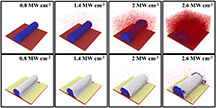Advance could bring commercial applications for silver nanowires
November 9, 2015
 |
|
New research shows wrapping silver nanowires, which are promising for applications such as flexible displays and solar cells, with an ultrathin layer of carbon called graphene protects the structures from damage and could represent a key to realizing their commercial potential. The lower images depict how graphene sheathing protects the nanowires even while being subjected to 2.5 megawatts of energy intensity per square centimeter from a high-energy laser, an intensity that vaporizes the unwrapped wires. The upper images depict how the unwrapped wires are damaged with an energy intensity as little as .8 megawatts per square centimeter. (Purdue University photo) |
WEST LAFAYETTE, Ind. — Silver nanowires hold promise for applications such as flexible displays and solar cells, but their susceptibility to damage from highly energetic UV radiation and harsh environmental conditions has limited their commercialization.
New research suggests wrapping the nanowires with an ultrathin layer of carbon called graphene protects the structures from damage and could represent a key to realizing their commercial potential.
"We show that even if you have only a one-atom-thickness material, it can protect from an enormous amount of UV radiation damage," said Gary Cheng, an associate professor of industrial engineering at Purdue University.
Devices made from silver nanowires and graphene could find uses in solar cells, flexible displays for computers and consumer electronics, and future "optoelectronic" circuits for sensors and information processing. The material is flexible and transparent, yet electrically conductive, and is a potential replacement for indium tin oxide, or ITO. Industry is seeking alternatives to ITO because of drawbacks: It is relatively expensive due to limited abundance of indium, and it is inflexible and degrades over time, becoming brittle and hindering performance, said Suprem Das, a former Purdue doctoral student and now a postdoctoral researcher at Iowa State University and The Ames Laboratory.
However, a major factor limiting commercial applications for silver nanowires is their susceptibility to harsh environments and electromagnetic waves.
"Radiation damage is widespread," said Das, who led the work with Purdue doctoral student Qiong Nian (pronounced Chung Nee-an). "The damage occurs in medical imaging, in space applications and just from long-term exposure to sunlight, but we are now seeing that if you wrap silver nanowires with graphene you can overcome this problem."
Findings appeared in October in the journal ACS Nano, published by the American Chemical Society. The paper was authored by Das; Nian; graduate students Mojib Saei, Shengyu Jin and Doosan Back; previous postdoctoral research associate Prashant Kumar; David B. Janes, a professor of electrical and computer engineering; Muhammad A. Alam, the Jai N. Gupta Professor of Electrical and Computer Engineering; and Cheng.
Raman spectroscopy was performed by the Purdue Department of Physics and Astronomy. Findings showed the graphene sheathing protected the nanowires even while being subjected to 2.5 megawatts of energy intensity per square centimeter from a high-energy laser, which vaporizes the unwrapped wires. The unwrapped wires were damaged with an energy intensity as little as .8 megawatts per square centimeter. (The paper is available at http://pubs.acs.org/doi/abs/10.1021/acsnano.5b04628)
"It appears the graphene coating extracts and spreads thermal energy away from the nanowires," Das said. The graphene also helps to prevent moisture damage.
The research is a continuation of previous findings published in 2013 and detailed in this paper: http://onlinelibrary.wiley.com/doi/10.1002/adfm.201300124/full. The work is ongoing and is supported by the National Science Foundation and a National Research Council Senior Research Associateship.
Writer: Emil Venere, 765-494-4709, venere@purdue.edu
Sources: Gary Cheng, 765 494-5436, gjcheng@purdue.edu
Suprem Das, srdaspurdue@gmail.com
Qiong Nian, qnian@purdue.edu
Note to Journalists: An electronic copy of the research paper is available at http://pubs.acs.org/doi/abs/10.1021/acsnano.5b04628, or by contacting Emil Venere, 765-494-4709, venere@purdue.edu.
ABSTRACT
Single-Layer Graphene as a Barrier Layer for Intense UV Laser-Induced Damages for Silver Nanowire Network
Suprem R. Das,*,†,‡,^,# Qiong Nian,‡,§,^ Mojib Saei,‡,§ Shengyu Jin,‡,§ Doosan Back,†,‡ Prashant Kumar,‡,§, David B. Janes,†,‡ Muhammad A. Alam,†,‡ and Gary J. Cheng*,‡,§
†School of Electrical and Computer Engineering, ‡Birck Nanotechnology Center, and §School of Industrial Engineering, Purdue University, West Lafayette, Indiana 47907, United States. ^These authors contribute equally to this work. Present address: Department of Physics, Indian Institute of Technology Patna, Patna 800013, India #Present address: Microelectronics Research Center, Applied Sciences Complex I, Iowa State University, Ames, IA
*Address correspondence to gjcheng@purdue.edu, srdaspurdue@gmail.com.
Single-layer graphene (SLG) has been proposed as the thinnest protective/barrier layer for wide applications involving resistance to oxidation, corrosion, atomic/molecular diffusion, electromagnetic interference, and bacterial contamination. Functional metallic nanostructures have lower thermal stability than their bulk forms and are therefore susceptible to high-energy photons. Here, we demonstrate that SLG can shield metallic nanostructures from intense laser radiation that would otherwise ablate them. By irradiation via a UV laser beam with nanosecond pulse width and a range of laser intensities (in millions of watt per cm2) onto a silver nanowire network, and conformally wrapping SLG on top of the nanowire network, we demonstrate that graphene "extracts and spreads" most of the thermal energy away from nanowire, thereby keeping it damage-free. Without graphene wrapping, the radiation would fragment the wires into smaller pieces and even decompose them into droplets. A systematic molecular dynamics simulation confirms the mechanism of SLG shielding. Consequently, particular damage-free and ablation-free laser-based nanomanufacturing of hybrid nanostructures might be sparked off by application of SLG on functional surfaces and nanofeatures.

